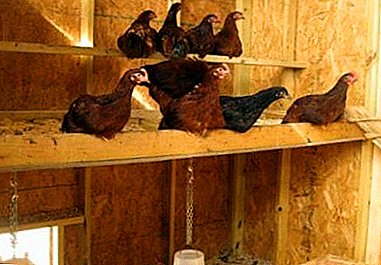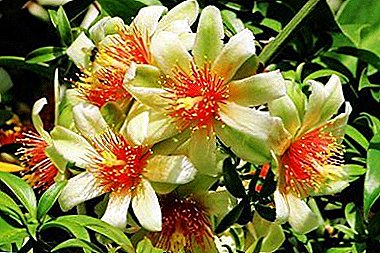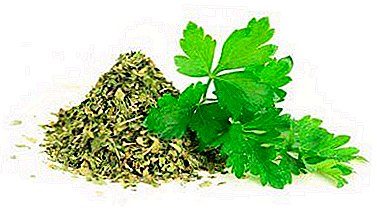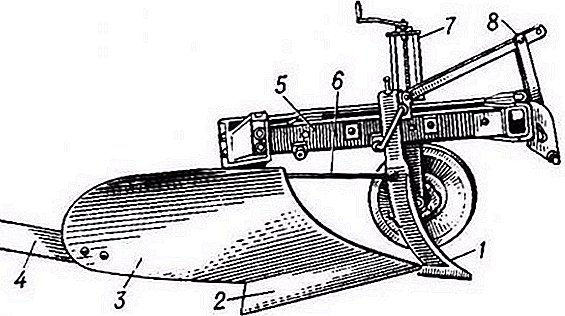 To obtain a good harvest, it is necessary to create favorable conditions for plants and soil. The earth must contain nutrients and oxygen. To do this, carry out tillage with the help of a plow. In the article we will tell what a plow is and what types of it are used most often.
To obtain a good harvest, it is necessary to create favorable conditions for plants and soil. The earth must contain nutrients and oxygen. To do this, carry out tillage with the help of a plow. In the article we will tell what a plow is and what types of it are used most often.
Device description
A plow is an agricultural machine that is used to plow the land. The principle of operation of the device consists in grinding the soil layers and further stalling it to the bottom of the formed depression in the ground.
Important! For plowing stony soil is to choose the unit with a lever mechanism. In case of its absence, the mechanism will run idle.During tillage, weeds and obsolete crop residues fall deep into the ground. Before plowing it is necessary to establish a depth of 18 to 35 cm. This indicator depends on the agronomic terms.
 The main parts of the unit include:
The main parts of the unit include:
- working bodies and mechanisms;
- support wheels;
- tow hitch.
Kinds
Depending on the purpose of the unit, various types of plows for tractors are distinguished. It is very important to choose the right mechanism for plowing - when using an unsuitable device, the technology of planting and growing plants can be disrupted.
The plow is selected depending on the tractor. The most common tractors in agriculture are: T-25, T-150, MTZ-80, MTZ-82, Kirovets K-700, Kirovets K-9000.
To destination
Before choosing a tool for processing it is important to decide what it is necessary for. Based on the objectives pursued, the following types of mechanisms:
- general purpose tool. As a rule, such a device has working bodies with a standard capture width, the size of which is 35 cm. With it, old arable soil is cultivated, which are subsequently sown technical, vegetable and grain crops.
- special purpose tool. This category includes plantation and garden units, the mechanisms by which stony, shrub-bog soils are cultivated, and the plowing of land for vineyards. Aggregates of longline type process chestnut and shale soils.

Different types of mechanisms have certain features in the management and use, so it is important to know exactly what type of unit is needed in a particular case.
By the nature of the applied thrust
Depending on the type of applied thrust emit following devices:
- horseback riding. Such mechanisms are most often used in small areas due to the inability to transport the tractor unit to the site;
- tractor plowman. Used in most cases of tillage, is a modern tool for plowing;
- rope thief. Such units are used for the treatment of wetlands in mountainous areas due to the lack of technical ability of the tractor device to operate in such conditions.
For small areas it is very convenient to use a mini-tractor, which can be made by hand.
Improper use of the mechanism necessarily leads to its breakdowns, so it is important to choose the most accurate device for a particular area.
By the hitch principle
Depending from the type of connection to the tractor emit The following types of devices:
- mounted plow. Differs in a simple structure and rather small weight. For the normal functioning of the mechanism, it is necessary to use a headland that has a small width. Being in the transport position, devices of this type transmit a small overturning moment to the tractor;

Important! In order for dust to get into the plow bearings as rarely as possible, it is necessary to press the stuffing box made of a felt and rubber cuff into the cap.
- semi-mounted plow. It has a small resistivity and a large turning radius. Being in the transport position, some of the mass of the unit falls on its rear wheel;
- trailed plow. Includes 3 wheels and a trailer, which are necessary to ensure the stability of movement and high quality plowing. As a rule, the trailed units include garden, longline units, as well as devices designed to handle shrub-bog soils.


By plow body design
Plow classification depending on the body includes mechanisms of such types:
- plowman. The most common type of unit, which has been used since ancient times;
- disk. With the help of such a tool plowed heavy, dried and overmoistened soils in irrigated areas;
- combined and rotational. Specialized units used in rare cases for processing different types of soil. Before use, a production check of these devices must be carried out.
Did you know? The first plow released for sale was developed in 1730 in England.
- chisel. They are used quite rarely due to the absence of the main feature of plowing - reservoir rotation.
Plow: tips and tricks for using the device
Regardless of what type of plow you are going to use, before starting work it is necessary to set up and adjustment mechanism. It consists in the following points:
- It is important to ensure the integrity of the design, if some components are loose, it is necessary to tighten them. Be sure to lubricate all moving parts and bearings.
- The adjustment of the depth of the land. The procedure is performed using the adjustment bolt. In case of insufficient tension, the ploughshare will go too deep into the ground.
- The height of the frame posts is checked. The location of the rods in the same plane is considered mandatory.
- At the final stage it is necessary to set the width of coverage. To do this, change the length of the traction. The greater the length, the greater the width of the equipment.
Did you know? In ancient times, the plow was a matter of respect. His theft was regarded as a serious crime and the thief carried a serious punishment.
When choosing a mechanism for tillage, it is best to contact an experienced friend or a specialty store. They will help you to make a choice and give advice on the use of the plow.












